With the doctor behind me, but very much still in the mind, I head north towards this “little temple on a mountain”. His words about the ills of the mind resonate but my philosophy has always been, ‘as long as there is enough tea with me, my mind – and whatever values and passions are at play – will sort themselves out.‘
The doctor of the mountains has the kind of rare but universal familiarity and charm that stays in the thoughts like a paste. His forcefulness and authenticity seem of another time. His absolute faith in the old ways being of value blended with a vitality that was hard not to admire and perhaps envy a little. His reverence is exactly what gives things integrity. What impressed was his complete openness to other villages and towns and even other peoples and to treating patients from wherever. He embodied the liberal philosophies that could only come from a purity of purpose, and if that purpose needed the odd jolt of firewater to inspire it forward, who could argue.
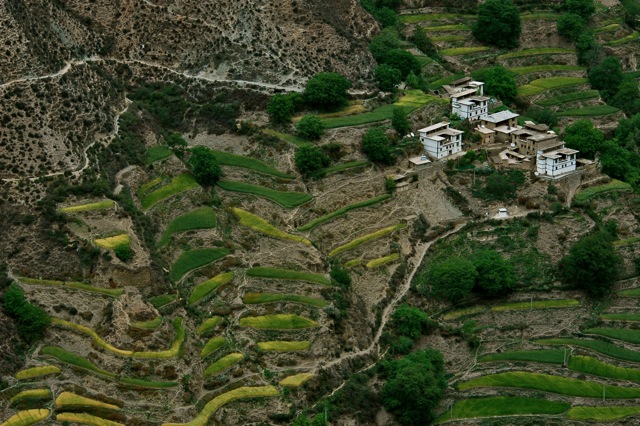
Every valley has character, dialect, architecture and traditions that vary ever so slightly from its neighbours
Valleys here are like small kingdoms and it is from these valleys that mini-empires evolved in the Tibetan lands. Rivers, mountains, and mountain passes formed protective and distinctive walls and barriers from one community to the next. Dialects, crops, and traditions might be similar but there is still much healthy paranoia of lands (and people) that might only be 20 km’s away. Naxi, Lisu, Han, and of course the Tibetan peoples occupy their own little hilltops and corridors of space here. Crops line every sun-friendly nook and it is perhaps these little worlds, separated by ridgelines and valleys, gorges and rushing rivers that define the land and its people.
It is a land of walnuts and mushrooms, of medicines, and of corn though it is still a place of relative poverty and isolation. Heat blankets the little worlds below three thousand meters and there is, as always, a longing to push higher into the thin-aired wonders up above.
The little mountain I’ve come to find with its attached temple seems as if it might not really exist but Aniè’s words have brought this on. A road sputters through pine trees up and further up. Aniè, the good doctore, told me I must walk the route to fully appreciate what it means to “get there”. For the mountain people, the whole adage of the “not the destination, but the journey” can be accurately summed up as “there is no destination without the journey, but there must be a destination.” A little pain imparts an appreciation and calluses on the hands and feet are not shameful, but rather proof positive that an effort was undertaken in these lands.
This whole idea of medicines for the mind and body come back again and again to me as I trudge through the forests, ever higher through and along a route which is strewn with pine needles. The acidic pine needles keeps the ‘floor’ of the forests clean of other plants with their ability to sterilize and insulate simultaneously. Mushrooms abound seemingly unaffected by the acidity and in late August and September the precious and often medicinal mushrooms and fungus that hide in the forests are collected for mouths and markets.
Small dirt paths are still used to access other towns just as they access this little monastery. Here to the west of Shangri-La (Zhongdian) lands are lower and don’t have the high plateau nor the pounding winds. Here the milder weather and better drainage provide a the setting for crops that can be found flush in every valley.
I miss the doctor’s energy and I wonder what he’d be explaining to me as I traveled as I’m sure his commentary wouldn’t end with medicines. His opinion would entertain as much as it would impart and having his lithe, energy-infused form next to me would certainly add dynamism to the trip.
Sitting in a little home on my way up for a break and accepting the generosity of a local family, I am again reminded of his mountain smarts as the house’s matriarch prepared butter tea. She herself explains in detail the glories and properties of yak butter.
“Hot butter with red sugar is used for stomach ailments and babies are given hot butter when they stop taking mother’s milk, to fortify their bodies.”
That isn’t it as she follows up with a recipe for dry and irritated eyes, with butter again being the star.
“We take a heated butter ball and wrap it in a cloth and use the steam to lubricate and protect the eyes.”
Western medicine’s tentacles haven’t yet reached into these lands that are still very much of the forests and hills. Here foodstuffs inevitably have ancient and vaunted healing qualities and those qualities are passed on through the spoken word. Even the simple walnut has its own list of brilliant qualities. Crushed and added to butter tea it is often consumed by pregnant women to allegedly assist the child’s brain development.
Soon I am again walking by foot with butter tea sloshing around inside of me and then the monastery Dongba Songjè monastery, utterly alone, is there peaking through the pine trees. It is as though someone glued it onto the south facing mass of stone. Prayer flags flow in every direction billowing in the winds and I feel that comforting loneliness when one is alone with time.
No bodies to be seen. Just a walkway leading along the monastery, which differs from many in that much of its main structure is adorned in wood as though affected by the local abundance in trees.
The walkway beckons as the doctor reminded me that I must circumambulate the entire mountain, not simply “show up and photograph it.”
A two-hour ‘kora’ of the mountain reveals no mortals, which in some small way keeps the sanctity of the place, but detracts from the feeling of it being a living, breathing space. Along a forested portion of the route I come upon one of the oddly personal aspects of Buddhism that I’ve seen many times throughout the mountains. It is both touching and spooky.
A fifty-square-metre portion of forest is covered with prayer flags, red string, and pieces of clothing, including discoloured shoes and trinkets. The red string is said to be the link and bridge so that those who pass on, have a road by which to travel after their lives have finished. Items of clothing are left to bless those that still live and those that have gone. Staring at the mass of tangled string and clothing it feels strange with all of these personal items that once belonged to people. Strands of red string tens of metres long, seem to encase and infuse the very forest in streaks of colour. Around me, there is only more silence as the odd bit of light bolts through the forest shredding through layers of green. Off to the left a small shoe fit for a baby dangles in a tree as some sort of blessing or parting gift and the whole place takes on an aspect of otherworldliness in the right here and right now.
Butter tea that night is provided by the local monks as well as a simple bed, and the memory of Aniè once again comes into the mind. Though I’m not at all sure that I’ve banished the ills of my mind, the air and silence give at least a temporary feeling of clarity. Night rushes in a hint of cold blue. In honour of this temporary clarity, I open up the supply of whisky Aniè passed on to me and let the warmth spread.


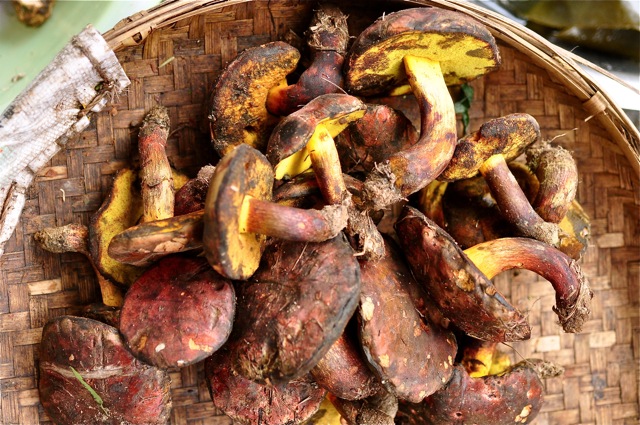
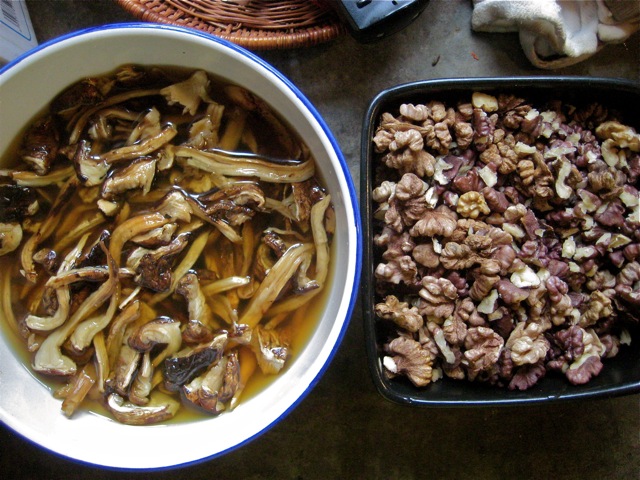
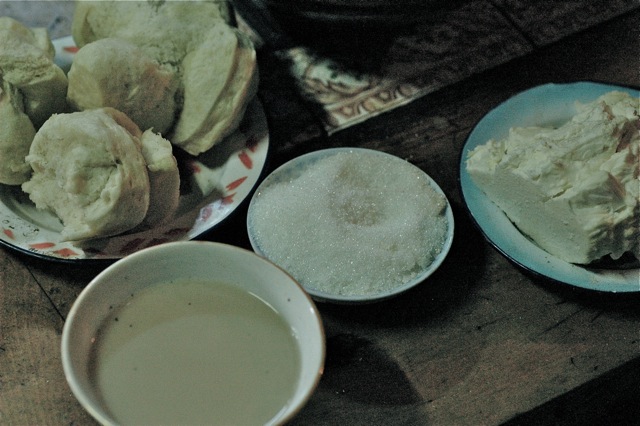
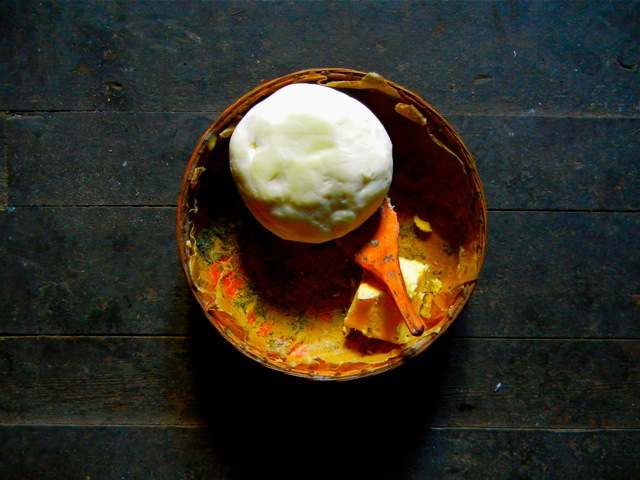
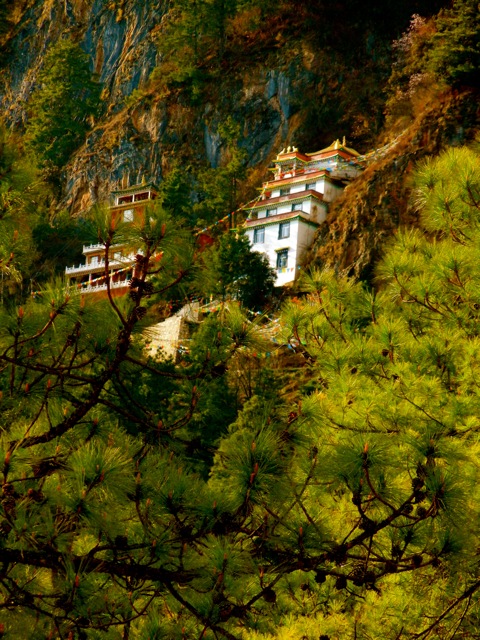
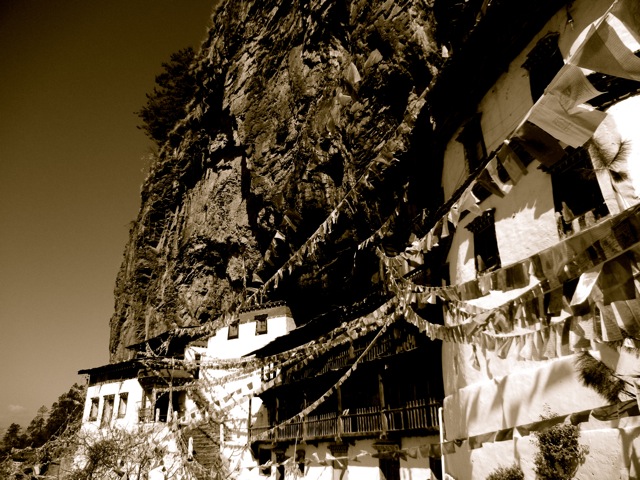
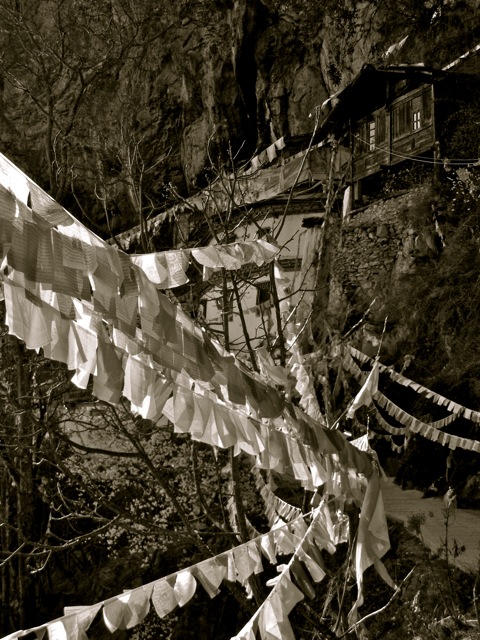
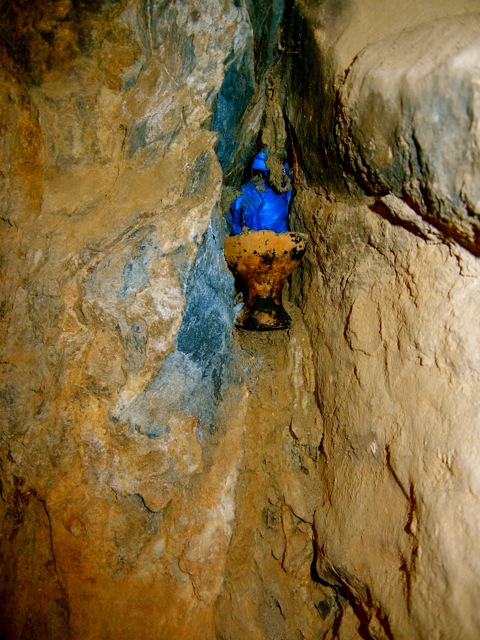
Hi Jeff,
I am glad you are there, ” haven’t yet dismissed its sighs, listen still….”. It helps us to recognize how beautiful the world is!
Hi Vinh,
I am glad I am here to…there are some wondrous places and some priceless characters around us.
Thanks for the note.
Jeff